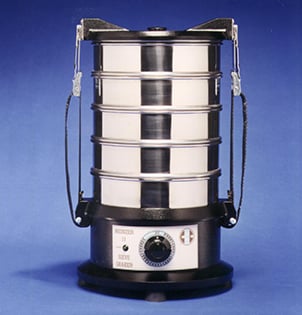The ongoing debate between the value of a sieve certification process and sieve calibration has long intrigued me.
Topics: Sieve Shakers, Mid-Point Sieves, Particle Size Analysis, Sieve Calibration, Sieve Testing, Sieves
I'm sure many of you have felt the jolt of static electricity when walking on a cozy wool rug in the winter and then reaching for a metal door knob. This same static electricity can cause chaos in your sieving process.
Topics: Sieve Blinding, Agglomeration, Sieve Testing, Sieves, Particle Size Test, electro static
Topics: Sieve Shakers, "Ask Art", Sonic Sifter, Agglomeration, Particle Size Analysis, Sieve Testing, Sieves, Sieving Process, Sieve Analysis, Quiet sieve shakers, sieve shaker
Visitors to our web pages often arrive with the question, “What is the Function of a Sieve Shaker?”
Topics: Sieve Shakers, "Ask Art", Sonic Sifter, Agglomeration, Particle Size Analysis, Sieve Testing, Sieves, Sieving Process, Sieve Analysis, Quiet sieve shakers, sieve shaker
We recently redesigned our E-commerce site. The redesign proceeded without a hitch, until we got to the sieves.
Read MoreTopics: Particle Size Analysis, Sieves, Sieving Process
Topics: Mid-Point Sieves, Sieve Calibration, Sieve Testing, Sieves
In 2011 "Powder-Bulk Solids" published an article comparing certification process veracity with a sieve calibration process using calibrated glass microspheres (or beads). The certification process merely indicates that a sieve mesh conforms to a standard that has a wide tolerance regarding mesh openings. It is performed on a small number of openings. On the other hand, calibration using the calibrated beads results in a number representing the mean opening -- a result generated by actually performing a test encompassing at least 80% of the mesh openings.
The problems outlined in the article are still dogging todays QC Managers
Topics: Sieve Shakers, Calibration, Particle Size Analysis, Sieve Calibration, Sieve Certification, Sieve Testing, Sieves, Sieving Process
Yes Harry, there is a Santa Claus. Or, more specifically, there really is a Holy Grail for ensuring consistent particle size analysis.
If you’ve been following along, you know it was proven by Pequeño and his family of 150 micron particles who tried to bust our friend Harry’s quality control by attempting to slip through the mesh in Harry’s test sieves and defeat sieve certification.
If you missed this drama, check out previous posts in the Holy Grail series here:
Is there a Holy Grail of Sieve Analysis?
Will Certification Lead to the Holy Grail of Sieving?
Does Calibration Light the Way to the Sieving Holy Grail?
Sieve Calibration is the Holy Grail!
And finally check out our eBook here: Free eBook
Now that we have indeed confirmed that, yes, sieve calibration really is the Holy Grail that sieve testers have been looking for, let’s get to work and dive a little deeper. Let’s examine some methods of sieve calibration.
Topics: Pequeño, Calibration, Particle Size Analysis, Sieve Calibration, Sieve Certification, Sieve Testing, Sieves, Sieving Process, du Nouy tensiometer, sieve mesh, particle sieze testing, sieve stack, Sieve Quality
You may remember Pequeño and his family of very small 150 micron (150µ) particles being very determined to defeat sieve certification.
Topics: Calibration, Particle Size Analysis, Sieve Calibration, Sieve Certification, Sieve Testing, Sieves, Sieving Process, Sieve Analysis, Sieve Quality
Does Calibration Light The Way To The Sieving Holy Grail
Posted by Art Gatenby on Aug 19, 2020 4:00:00 PM
All about sieve Calibration
We continue to search for answers to the question "Is Sieve Calibration Really the Holy Grail?" Pequeño, you may remember him as a very small (150-micron) particle who has many similar-sized family members. They are determined to defeat Brad and his Sieve Certification.
Foiling A Sieve Test
Topics: Calibration, Particle Size Analysis, Sieve Certification, Sieve Testing, Sieves, Sieving Process, Sieve Analysis










